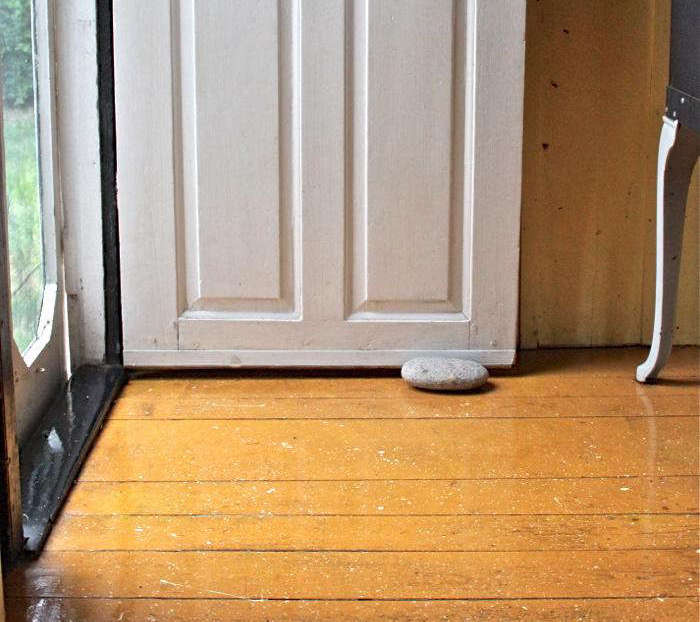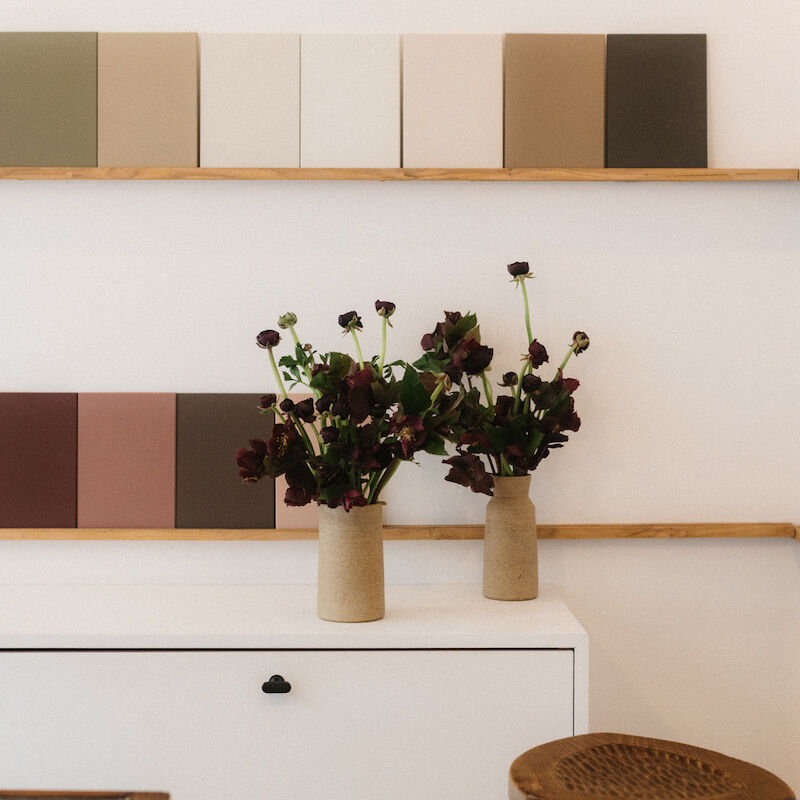Editor’s note: This is the second in a series of posts by Sally Kohn— journalist and CNN political commentator, TED talk giver, and design aficionado—chronicling her adventures in remodeling. For the first installment, see Remodeling 101: The Case for Unstained Wood Floors, from a Stealth Design Nerd.
I don’t know why I love spray paint so much, but it’s probably because I’m lazy. Specifically, I don’t like rinsing out paint brushes. This seems very non-environmental of me, and let’s be clear, that’s correct, but there you have it. Then I end up buying cheap disposable paint brushes, and those just lead to constant falling-out bristles that get into my paint job, and so…spray paint!
When I lived in a Brooklyn apartment for 14 years, this was a mostly unrequited love. For the most part, spray painting indoors is not smart, especially in a fairly tiny apartment with lots of original wood.
But still, I learned to love spray paint. We had an old wood chair from my partner’s grandmother that the years—and an unfortunate choice of blue paint—had rendered unusable. Over the course of weeks and weeks, we sanded it down, re-glued the legs, and meticulously painted multiple coats with brushes until it was a revived and lovely sunny yellow. Gorgeous results, but extremely time consuming.
Then, a year or so later, I realized if I cut the legs off our wooden stools, we would no longer have to forcefully smush our thighs to the side in order to sit at our kitchen counter. I went to my parents’ house in the country, chopped the legs off, and spray -painted three stools in just a few hours. And I could even find a shade of yellow spray paint to almost perfectly match the hand-painted chair. Game. Changer. Now I’m a spray paint evangelist for life.

The Origins of Spray Paint
It turns out, funnily enough, that spray paint was invented in Sycamore, Illinois, my partner Sarah’s hometown—a place heretofore only famous for its pumpkin festival, which is to say not that famous. Less funny is the fact that though Ed Seymour is credited as the inventor of spray paint, it was actually his wife who had the idea for applying paint with the sort of spraying mechanism found in deodorizers at the time. I’d personally like to give Ed’s wife the credit, but I don’t know her name. And then I’d like to spray paint some graffiti somewhere about patriarchy.
Just a Few Ways to Use Spray Paint
This is not an exhaustive list but rather a list of things I have personally done with spray paint with delightful results:
- Buy a mismatched medley of cheap yard sale and flea market chairs, spray-paint each one, and create a fun seating vignette (in my case, for my backyard dining area)
- Spray-paint old, visible screws on a light switch plate before reinstalling it (ever so carefully)
- Take a random mix of objects and spray-paint them all the same color to end up with a deliberate-looking, chic display collection for the mantle
- Add personality to the mailbox (since taking off the old mailbox at the home I bought and buying a new one seemed silly, I spray-painted the old one green and then made the flag hot pink, which is fun)
- Spray-paint the metal legs of an Ikea desk chair and the handles of Bisley file cabinets to create a consistent, matched, metallic vibe

Five Tips for Successful Spray-Painting
In my experience, if you ask for tips, you get a lot of them that are really not that useful. But some spray paint tips are really important.
N.B.: Importantly, we suggest opting for low-VOC spray paint, of which there are (finally) now many options. If you don’t have an outdoor space and must paint inside, open the windows and wear a good quality mask.
1. Spray outside if possible.
My top tip is spraying outside. As noted, painting inside is hard: The paint can get everywhere, even if you cover other surfaces, and the fumes are pretty nasty. Fresh air helps.
As a rule, I tend to put down giant pieces of old cardboard on my lawn and spray-paint there. That way, if the paint spreads, at least it’s on the grass that gets cut (eventually). Another great idea is making a little spray-paint box with a stick across the top that you can hang things on; then, spray from above into the box or open one side of the box to spray at the hanging items. The paint is mostly contained by the box. Just watch out later—somehow, even after days, the spray paint on the box can often rub off onto your hands/clothes/dog.

2. Use a primer, always.
I forget to use a spray paint primer every single time I spray paint, and every single time I regret it—especially when my dried spray paint starts peeling off in giant pieces. Get a good primer and prime first. Every time. You’ll be glad.
That being said, I mostly use Rust-Oleum’s Painter’s Touch spray paints, which are a combined primer and paint in one—and, bonus, come in matte. The red, for instance, on my chairs is their yummy Poppy ($6.48 at Home Depot).
3. Apply multiple thin coats.
One of the lessons I learn the hard way over and over again is that multiple thin coats is about a thousand times better than one or two thick coats. Just give the surface of your furniture or object a light spraying treatment. Unless it’s rainy or really muggy, most spray paint dries in an hour or two, so then you can just do another coat and another and another until you’re satisfied. This is much better than having giant runny drips on your finished product.
As a general rule, you don’t want to be too close when you’re spraying. I usually shoot for a foot away, maybe a smidge less. And spray not just from edge to edge but actually off the edges of your piece. Otherwise, you’re likely to get some pooling and drips from overpaint on the edges of your project.
4. Use a top coat.
Big, big fan of top coat here. I use clear matte finish spray—usually either Rust-Oleum’s Painter’s Touch matte clear or Minwax Polycrylic matte clear—to top off basically everything I do.
To be clear, the yard sale chairs that I didn’t sand down and forgot to prime and then painted and put around a table in my backyard and left there through a whole summer and fall of rainstorms have started chipping and peeling a smidge—but they would be totally unusable were it not for a few coats of protective finish spray. I also just made a sign to put at the end of my driveway diverting deliveries to my package box, and after I stained a piece of wood and painted lettering on it, I hit it with a few coats of Minwax Polycrylic matte clear, and it still looks just as good as when I finished it.

5. Be prepared to get messy.
Get a pair of junky sneakers or shoes that you use for spray painting; these are actually also helpful for all painting (drips, anyone?). Early on this summer, I made the mistake of using blue glitter spray paint while wearing sandals. I had semi-permanent blue stripes on my feet for several weeks of beach season. So watch out there.
Final point: I ignore a lot of the rules above a lot of the time. I’m impatient, I should sand things down before I spray them, I should spray thinner coats, etc. And sometimes I do when I want perfection. But sometimes I’m using spray paint in the first place because I want a quick and dirty solution and I’m okay with a more rough, quick, and dirty outcome. So know that going into your spray paint adventure: quality effort in, quality results out.
N.B.: For info on how and where to recycle spray paint cans once you’re through with them, head here.
For more painting tips and tricks, see:
- Remodeling 101: 12 Essential Tips for the Perfect Paint Job
- Expert Advice: How to Choose Paint Like a Pro
- 10 Things Nobody Tells You About Painting Furniture
Frequently asked questions
What is spray paint?
Spray paint is a type of paint that comes in an aerosol can. It contains pigments and a propellant that allows the paint to be sprayed onto surfaces evenly and smoothly.
What surfaces can be spray painted?
Spray paint can be used on a variety of surfaces, including wood, metal, plastic, wicker, glass, and more. It provides good coverage and adheres well to most materials.
What are the benefits of using spray paint?
Using spray paint offers several advantages, including:
Ease of application: Spray paint allows for quick and even coverage, making it easier to achieve a smooth and professional-looking finish.
Versatility: It can be used on a wide range of surfaces and is available in various finishes, such as matte, satin, gloss, or metallic.
Time-saving: Spray painting is faster than traditional brush painting, especially when working on large or intricate surfaces.
Seamless finish: The fine mist of spray paint helps to minimize brush strokes, resulting in a seamless and uniform appearance.
Can I spray paint indoors?
While it's possible to spray paint indoors, proper ventilation is crucial. Ensure that the area is well-ventilated by opening windows, using fans, or working in a well-ventilated room or garage. It's also recommended to cover surrounding surfaces and objects to protect them from overspray.
Do I need to prepare the surface before spray painting?
Yes, surface preparation is important for a successful spray paint job. Clean the surface thoroughly to remove dirt, dust, and grease. If necessary, sand the surface lightly to create a better adhesion for the paint. Use a primer if recommended for the specific material or if you're painting over a dark or uneven surface.
How do I achieve a smooth finish with spray paint?
To achieve a smooth finish with spray paint, apply thin and even coats. Hold the can about 8-12 inches away from the surface and use smooth, sweeping motions. Avoid spraying too close or applying too much paint at once, as it can lead to drips, uneven coverage, or a textured finish.
Can I use spray paint to refinish furniture?
Yes, spray paint is a popular choice for refinishing furniture. It can give a fresh new look to old or outdated pieces. Ensure that the furniture is properly cleaned, sanded, and primed before applying the spray paint. Use multiple thin coats for a durable and professional-looking finish.






Have a Question or Comment About This Post?
Join the conversation